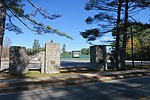Surry Mountain Lake

Surry Mountain Lake is a 353-acre (1.43 km2) impoundment on the Ashuelot River in Cheshire County in southwestern New Hampshire, United States, in the town of Surry. The reservoir was built to protect downstream communities, such as Keene, from flooding. Surry Mountain Dam was built by the United States Army Corps of Engineers in 1941 as an earthen rock-fill structure. Its height is 83 feet (25 m), its length is 1,800 feet (550 m) at the crest, with a maximum capacity of 44,000 acre-feet and a normal capacity of 1,320 acre-feet. Both dam and reservoir are owned by the Corps of Engineers.The lake is classified as a warmwater fishery, with observed species including rainbow trout, brown trout, smallmouth and largemouth bass, chain pickerel, horned pout, and black crappie.
Excerpt from the Wikipedia article Surry Mountain Lake (License: CC BY-SA 3.0, Authors, Images).Surry Mountain Lake
Surry Dam Road,
Geographical coordinates (GPS) Address Nearby Places Show on map
Geographical coordinates (GPS)
| Latitude | Longitude |
|---|---|
| N 42.998333333333 ° | E -72.309722222222 ° |
Address
Surry Dam Road
Surry Dam Road
New Hampshire, United States
Open on Google Maps








